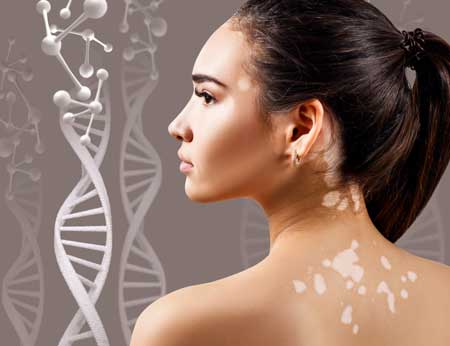 Vitiligo and Leucoderma are two common skin conditions characterized by an external white spot on the skin. It is often difficult to tell the difference between Vitiligo and Leucoderma.
Vitiligo and Leucoderma are two common skin conditions characterized by an external white spot on the skin. It is often difficult to tell the difference between Vitiligo and Leucoderma.
What is Vitiligo?
This is a long-term skin condition that is characterized by pale white patches that develop on the skin due to a lack of skin pigmentation known as Melanin. Vitiligo can affect any part of our skin, but it usually involves the area that is extensively exposed to the sun, including the face, neck and hands. Although the exact aetiology of this condition is not clearly known, it is believed that certain autoimmune conditions and underlying health problems related to nerve endings, sudden emotional trauma and stress are increasing the risk. Other causes of vitiligo can be regular consumption of vegetables and fruits treated with insecticide / pesticide, recurrent episodes of jaundice or typhoid, treatment with heavy antibiotics, treatment with corticosteroids and poor personal hygiene.
In 50% of affected individuals, the initial skin changes would appear before age 20, but not as a general rule. Men and women are equally affected, and there is no known prevalence in any ethnicity.
This condition can usually be accurately diagnosed by taking a complete patient history and having a thorough physical examination of the affected areas of the skin. This is mainly done using an ultraviolet lamp, which shines on the skin to get a better view and rule out other skin conditions. Other tests will also be performed to rule out conditions such as Diabetes or Hyperthyroidism.
White patches on the skin caused by vitiligo do not have a permanent cure, but the appearance can be improved with certain medications. In fact, relatively small blemishes can be hidden with skin camouflage creams or cosmetic concealers. In addition, severe and extensive blemishes can be treated with a combination of treatments, including phototherapy and medication.
However, as the spread of the disease cannot be completely stopped, it is important to advise affected individuals to minimize exposure to sunlight to avoid negative outcomes. With regard to Vitiligo complications, a lack of Melanin can result in sunburn and may increase the risk of skin cancer caused by chronic exposure to the sun's ultraviolet rays. In addition, some individuals may be affected by lack of pigmentation in the eyes and partial hearing loss, known as hypoacusis.
Furthermore, this can also result in problems related to confidence and self-esteem, so it is highly important to get social support from such social and charitable services in order to change the negative attitudes of the community towards Vitiligo.

What is Leucoderma?
Leucoderma is basically a depigmentation of the skin marked by the location or eventual destruction of melanocytes. The characteristic white patches are narrowly limited on the skin compared to vitiligo. Some people even suggest that Vitiligo is a form of Leucoderma, but there is no scientific evidence to support it.
Common causes of Leucoderma include traumatic incidents such as accidental cuts, burns and ulcers, where the end result would be scarring, thus resulting in a gradual development of a white patch.
Leukoderma is primarily identified by white patches that would be located in smaller areas at first, but tend to dilate over time. Most of these skin changes begin to be noticed around the age of 10 and 30 years and would be most noticeable in people with dark brown skin. The main objective of the treatment includes the correction of metabolism, improving immunity, increasing the capacity of possible pigmentation on the affected area.
Difference between vitiligo and leucodermia
Clinical Features
With regard to the clinical presentation, both Vitiligo and Leucoderma consist of white patches that can only be differentiated by cause. But, in some patients, raised spots may be evident in leucodermia without the use of a light source, although it is very difficult to differentiate between
them.
Cause
Vitiligo is primarily caused by autoimmune conditions, hormonal changes, acute emotional trauma or stress, recurrent episodes of jaundice or typhoid, prolonged antibiotic treatments or treatment with corticosteroids.
Leucoderma will occur strictly after physical trauma such as a cut, burn or ulceration. The scar that will ultimately form will turn into a white spot that can sometimes increase in size over time.
Diagnosis and Treatment
Being two clinical diagnoses, a complete history and physical examination especially of skin changes are very important in deciding on the treatment plan. Concealing creams and phototherapy would help in most patients, but their progression cannot be stopped due to their lifelong nature.
